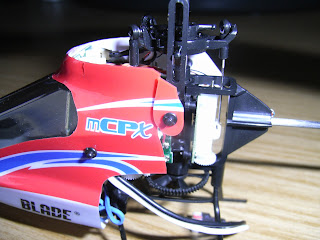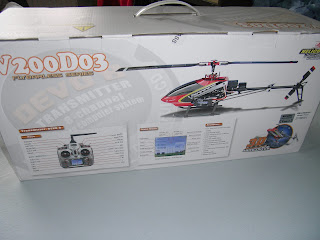Yes, something I had been anticipating the arrival of and it arrived today.
Eagerly opening the parcel I found what I expected: the new
Walkera V200 D03 flybarless collective pitch helicopter that I am going to review. So I thought that I would start here by giving you my thoughts and findings as I opened the box.
It comes with the all new 8 channel 2.4GHz touch screen programmable Devention transmitter, which is a definite step up from anything Walkera have previously packaged with an RC helicopter like this.
As always with Walkera everything is very nicely packaged and neatly compartmentalized.
The box has its own carry handle so that it doubles as a storage and carrying case. OK a nice metal case is very nice but they are a pricey extra (unless you are buying an RTF
CopterX Black Angel Pro RC Helicopter which some stores will provide with an aluminium case included for no extra).
I previously had a Walkera V200 D01 which superficially the D03 looks very much like. The D01 however is a fixed pitch helicopter whilst the D03 is a collective pitch and actually shares its origins with the Walkera 4F200 rather than the V200 D01/02. The D01 I found to be a brilliant helicopter, solidly constructed and beautiful to fly with very good tail holding with its shaft driven tail. Both of these radio controlled helicopters use the new flybarless system that Walkera is rightly favouring on all its new models. They utilize a 3-axis gyro which gives great flying performance and the electronics allow you to adjust the gyro settings through the receiver so that you can make it as stable as you like, making it very docile for a novice, or you can crank it up to give a much more agile and faster performance (see the video in the first blog entry of a V200 D01). I like the D01 very much.
The V200 D03 should be much more powerful, being capable of 3D aerobatics, and I will be interested to see also how docile and stable it can be made through adjustment of the gyro and transmitter settings. One of the beauties of a fully programmable transmitter is that you can set the helicopter up exactly to your requirements (more on this in future postings) and with the Devo 8 this can be done through the built in touch screen, making the functions very accessible and hopefully very easy - providing it is intuitively devised.
The Devo 8 immediately has a much more solid feel to it than the transmitter that came with the V200 D01. In fact in terms of both looks and feel it has similarities to the wonderful
Spektrum DX7 that I use with my other RC helicopters. In fact the Devo 8 immediately has a couple of pluses even over that market leading transmitter.
- It has a backlit LCD screen
- You do not have to remove the back of the transmitter to adjust the tension on the throttle stick. I always dislike having to do this so it was a pleasure to find that the Devo 8 has a little rubber grommet covered access hole to a Phillips head screw to do this.
This transmitter of course also has a touch screen which the
Spektrum transmitters do not but whether you regard that as a plus or not is very much a matter of personal opinion and I will report later on how I find that works. Of course what is still to be determined is whether the electronics and reliability of the Walkera radio can compare to Spektrum, who also have second to none customer service. I managed to drop my
DX7 simply picking it up in the house (it is normally firmly strapped to my neck) and in the fall it broke a dual rate switch lever. I phoned Horizon Hobby tech support and they sent out a replacement switch for free. They didn't even charge me for the postage. All I had to do was unscrew the old one and solder in the new switch myself. I might add that I have heard many other similar stories of Horizon Hobbies excellent customer support.
One thing that did concern me about the Devention 8 transmitter was that at first sight it does not appear to have a throttle hold switch, which is absolutely essential with a collective pitch helicopter. With anything less you can just knock the throttle stick right down if you are going to come down so as to kill the power and minimize damage. With a collective pitch helicopter this is possible whist in the normal flight mode but once you go into Flight Mode 1 or 2, the bottom half of the stick gives you negative collective and does not reduce the throttle so you can not knock the power off. Fortunately, a quick scan of the provided User Manual for the transmitter revealed that the Rudder Dual Rate switch can be changed to function as a Throttle Hold switch. Which actually most transmitters use this switch as an either/or for the two functions. I was slightly disconcerted that Walkera have elected the situate the Rudder Dual Rate/Throttle Hold switch and the Flight Mode switches the opposite way around to the Spektrum transmitter. I am so used to reacting with the right hand to hit throttle hold in an emergency and here I will have to react with the left hand - and it is usually needed in situations when you do not have time to think about it - you need to react instantaneously. The other factor is that there is a risk of reaching with the left hand to change the flight mode, as I would on the Spektrum, and in doing so with the Walkera I would put the helicopter into throttle hold killing all power to the rotor head. Care will be needed!
Whilst talking of power losses, one other thing I do not care for with this helicopter is that there is no auto-rotation gear. So if you do happen to have a failure in mid-air that results in no power getting to the main blades you have no safe way down. Come on Walkera - a helicopter of this quality and cost deserves a failsafe like this.
So what else about the helicopter itself. As usual for Walkera R/C helicopters it is beautifully finished.
It has a metallic red anodized rotor head which is a wonderful match for the canopy.
The carbon fibre rotor blades look stunning (but will not be cheap to replace - I may have to find some more reasonably priced plastic ones for general use, at least until I am more used to flying this beauty).
Everything is indeed very neat with this helicopter and it has a nice sturdy feel to it, just like the V200 D01, but without costing excessive weight for it (342g without the lipo battery).
One nice touch - this helicopter came directly from China, but unlike many other companies Walkera supplied it with the correct plug (a clip on head) for the lipo charger power supply. It is so nice to get a UK 3-pin plug for a change.
On the supplied manuals. In the box there is a booklet type paper 'User Handbook' which covers the helicopter and basic setup and function of the Devo 8. Additionally there is a Devention 'User Manual' for the Devo 8 which covers all the functions of the transmitter. This is on a CD. Now I don't know if Walkera just could not make their mind up as to which format they were gong to use or what but if they were just trying to please both people who like their written material on paper and those who like it in digital format they will end up satisfying none - it is a strange logic they have used!
As to the contents of the manuals, on a brief scan through it appears comprehensive enough but it is the usual translated Chinese English, which means that you have to read it very carefully and probably a few times over in places to comprehend it properly. One wishes that they would use people whose native language is English to do the translations for them rather than Chinese people who speak English - but then this is a common problem almost universal to all Far Eastern goods with instructions enclosed. As they go the translations here are actually not bad at all.
Overall I'm really excited about this little heli and I am looking forward to programming the transmitter, completing the setup and getting it airborne. Shame the weather has gone so wet and windy. This hobby is excellent for developing patience - you learn to do so or develop a big whole in your pocket!
I will be reporting back here on how the setup goes and giving some flight reviews in coming posts.
A little peak at what else is to come: I have a
Trex 450 SE V2 clone ARF that has been sitting in the cupboard waiting to be set up and I am going to be going through that step by step as it is a very common helicopter for many many hobbyists. So I feel it may be beneficial to go through it here as getting the initial setup right is so important. I have decided to do it with settings for a novice at flying this type of machine to demonstrate how they can be tamed down to make them more manageable.
There is so much more planned. I hope you will be joining me as we journey together through this exploration of the RC Helicopter World.





















